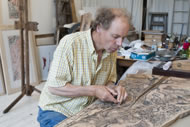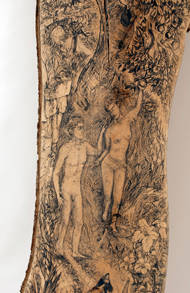David Risk Kennard was born in England in 1953 and attended Marlborough College, where he flourished in the art school under the direction of Richard Shirley Smith, a wonderful wood engraver, artist and illustrator. Art history lectures were “fantastic”, he recalls. And it was at Marlborough that he learned to draw and to indulge in refined imagery. From there, he went to Bower Ashton in Bristol, where drawing trees became his forte. He was, he says, somehow drawn to them and they to him.
David now lives in Dorset with his wife, Angelica. His home – the village of Powerstock – is well insulated from the outside world. Rolling hills fold in at every point, and sheep graze in the distance. David lives in a forest that he planted himself. Like Jean Giono’s Man Who Planted Trees, he has surrounded himself with his very own ‘friends’: tall walnut trees, Scots pines, hazels, a plum tree or two, cherries, a birch, a beech, a sycamore, an oak or three. His own piece of paradise. Four years ago he decided to pick up a chisel. This is hands-on work. The cutting edge.
I admired his solid wooden dining table over lunch, which was made from two ash planks. We agreed that there are no flat surfaces in Dorset, that everything is curved, and that Nature takes its own ways with time and texture. His studio is crammed full of long lengths of tree. He carves the whole tree, or at least a vertical section of it maybe 12 foot high, and in so doing he reveals the inner texture. He uses the tree to inform his own inner landscape.
The forest has crept indoors.
Time is not linear in West Dorset. David works in mythological time. There is a kind of magical realism such as is found in the novels of Giono: a heightened awareness of light and texture, as if the trees are speaking, as if the grain is yielding up its own inner landscape to his chisel. The figures grow of their own accord. The flanks of trees surround the walls of his studio. Pear, cherry, cedar, field maple, hawthorn. These landscapes have been scrumped. His finest work, Garden – a Dorset Eden in the making – is carved in lime.
And then I learn that David once lived in the woods and it seems as if the trees are about to engulf his imagination – and yet these forests help him to survive. The front line is at the front door; his art is carving time. He is living in the mind of the forest, and yet the forest is of his own creation.
David has broken the mould of his own work and is now ploughing his own furrow, but it is one that has deep imagination and resonance for all of us.
He has at last come home.
For more on the work of David Risk Kennard visit www.riskkennard.co.uk









